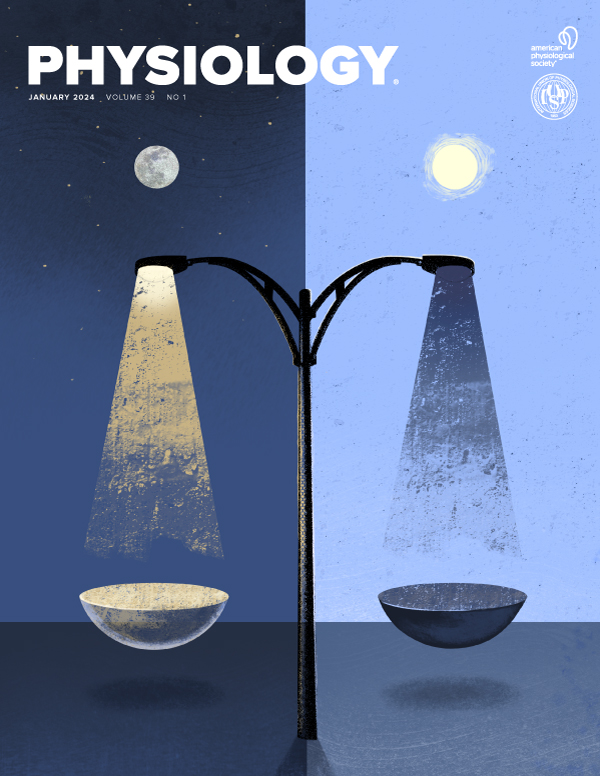厄洛替尼抑制表皮生长因子受体可通过 PDK1 和 RSK 激活诱导 aquaporin-2 在膜上积聚
IF 5.3
2区 医学
Q1 PHYSIOLOGY
引用次数: 0
摘要
在典型的水通道蛋白-2(AQP2)信号传导途径中,血管加压素(VP)与其V2受体结合,进而激活腺苷酸环化酶和蛋白激酶A(PKA),导致AQP2 S256磷酸化和AQP2在膜上聚集。表皮生长因子受体(EGFR)抑制剂厄洛替尼也会增加 AQP2 S256 磷酸化和膜积聚,但它不会增加 cAMP 或 PKA 活性。我们推测,在厄洛替尼激活的这种新型 PKA 非依赖性途径中,EGFR-MAPK/ERK 途径的下游效应物核糖体 s6 激酶(RSK)是使 AQP2 磷酸化的末端激酶,而磷脂酰肌醇依赖性激酶-1(PDK1)是 RSK 的公认激活剂,是厄洛替尼诱导的 AQP2 激活不可或缺的因素。通过使用 LLC-AQP2 细胞模型,我们发现厄洛替尼诱导的 AQP2 膜积聚和 S256 磷酸化会被特异性 RSK 抑制剂 BI-D1870 废止。用 siRNA 敲除 RSK 也能阻断 AQP2 S256 磷酸化和膜积聚,用 CRISPR/cas9 编辑敲除 RSK 也是如此。接着,将大鼠肾脏切片放入含有或不含 BI-D1870 的 Hank's 缓冲液中培养,并用厄洛替尼处理。BI-D1870 抑制了集合管主细胞中 AQP2 膜的积聚,从而证明了这一通路在肾脏细胞原位中的相关性。使用纯化蛋白进行的体外激酶试验表明,RSK 可直接将 AQP2 的 S256 残基磷酸化。此外,厄洛替尼持续增加 RSK T359 的磷酸化,该残基与 RSK 的活性状态有关。在典型的 RSK 激活过程中,磷酸化级联导致 PDK1 与 RSK 结合并激活 RSK。我们发现,用实验化合物 PS-222 抑制 PDK1 还能阻断厄洛替尼诱导的 AQP2 膜积聚和 S256 磷酸化。这表明 PDK1 与 RSK 一起参与了厄洛替尼诱导的 AQP2 转运的新途径。我们的数据表明,RSK 和 PDK1 是厄洛替尼诱导的不依赖 PKA 的新型 AQP2 激活途径的终端效应器。对这一新的非经典途径的进一步研究有望发现治疗水平衡失调的潜在药理靶点。这项工作得到了美国国立卫生研究院(NIH)DK096586(D. Brown)基金的支持。P. W. Cheung 得到了美国国立卫生研究院 K-award DK115901 的支持。Richard Babicz 是 Ben J Lipps 研究奖学金(美国肾脏病学会)的获得者。波士顿地区糖尿病和内分泌学研究中心(DK057521)和麻省总医院(MGH)炎症性肠病研究中心(DK043351)为膜生物学显微镜核心项目提供了额外支持。本文是在 2024 年美国生理学峰会上发表的摘要全文,仅提供 HTML 格式。本摘要没有附加版本或附加内容。生理学》未参与同行评审过程。本文章由计算机程序翻译,如有差异,请以英文原文为准。
EGFR inhibition with erlotinib induces membrane accumulation of aquaporin-2 via PDK1 and RSK activation
In the canonical aquaporin-2 (AQP2) signaling pathway, vasopressin (VP) binds to its V2 receptor, which in turn activates adenylate cyclase and protein kinase A (PKA), resulting in AQP2 S256 phosphorylation and accumulation of AQP2 in the membrane. The epidermal growth factor receptor (EGFR) inhibitor erlotinib also increases AQP2 S256 phosphorylation and membrane accumulation, yet it does not increase cAMP or PKA activity. We hypothesize that the ribosomal s6 kinase (RSK), a downstream effector in the EGFR-MAPK/ERK pathway, is the terminal kinase phosphorylating AQP2 in this novel PKA-independent pathway activated by erlotinib, and that the phosphoinositide dependent kinase-1 (PDK1), a well-established activator of RSK, is indispensable for erlotinib-induced AQP2 activation. Using our LLC-AQP2 cell model, we show that erlotinib-induced AQP2 membrane accumulation and S256 phosphorylation are abolished by the specific RSK inhibitor BI-D1870. RSK knockdown with siRNA also blocked AQP2 S256 phosphorylation and membrane accumulation, as did RSK knockout with CRISPR/cas9 editing. Next, rat kidney slices were incubated in Hank’s buffer with or without BI-D1870 and treated with erlotinib. BI-D1870 inhibited AQP2 membrane accumulation in collecting duct principal cells, supporting the relevance of this pathway in kidney cells in situ. An in-vitro kinase assay using purified proteins demonstrated that RSK directly phosphorylates AQP2 at the S256 residue. Additionally, erlotinib consistently increased phosphorylation of RSK T359, a residue associated with RSK’s active state. In canonical RSK activation, a phosphorylation cascade results in PDK1 binding to and activating RSK. We found that PDK1 inhibition with an experimental compound PS-222 also blocked erlotinib-induced AQP2 membrane accumulation and S256 phosphorylation. This implicates PDK1 along with RSK in the novel erlotinib-induced pathway of AQP2 traffcking. Our data show that RSK and PDK1 are terminal effectors in the novel, PKA-independent pathway of AQP2 activation induced by erlotinib. Further elaboration of this new non-canonical pathway promises to uncover potential pharmacological targets for the treatment of water balance disorders. This work was supported by the National Institutes of Health (NIH) grant DK096586 (D. Brown). P. W. Cheung was supported was supported by NIH K-award DK115901. Richard Babicz is the recipient of the Ben J Lipps Research Fellowship (American Society of Nephrology). Additional support for the Program in Membrane Biology Microscopy Core came from the Boston Area Diabetes and Endocrinology Research Center (DK057521) and the Massachusetts General Hospital (MGH) Center for the Study of Inflammatory Bowel Disease (DK043351). This is the full abstract presented at the American Physiology Summit 2024 meeting and is only available in HTML format. There are no additional versions or additional content available for this abstract. Physiology was not involved in the peer review process.
求助全文
通过发布文献求助,成功后即可免费获取论文全文。
去求助
来源期刊

Physiology
医学-生理学
CiteScore
14.50
自引率
0.00%
发文量
37
期刊介绍:
Physiology journal features meticulously crafted review articles penned by esteemed leaders in their respective fields. These articles undergo rigorous peer review and showcase the forefront of cutting-edge advances across various domains of physiology. Our Editorial Board, comprised of distinguished leaders in the broad spectrum of physiology, convenes annually to deliberate and recommend pioneering topics for review articles, as well as select the most suitable scientists to author these articles. Join us in exploring the forefront of physiological research and innovation.
 求助内容:
求助内容: 应助结果提醒方式:
应助结果提醒方式:


